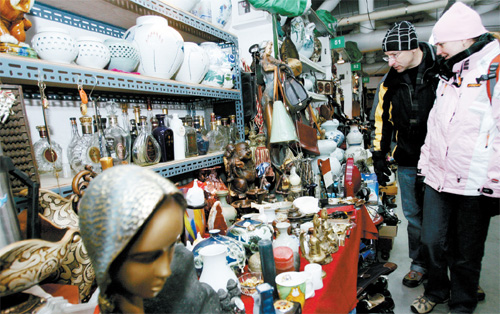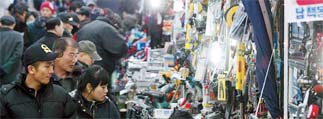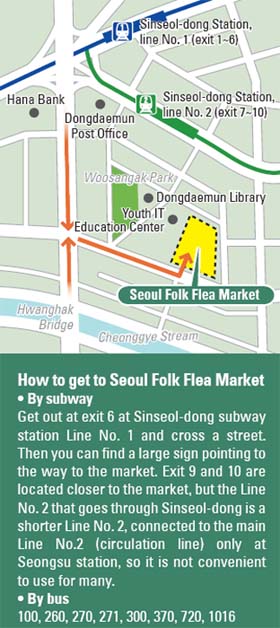Flea market is awash in used goods

Foreigners are also attracted to the Seoul Folk Flea Market where they can buy items that reflect Korea’s past. By Jeon Min-kyu
Some call it the Dokebi (goblin) Market because broken goods get fixed like magic.
Others know it as the Junk Market. Some call it, appropriately, the Last Market. The merchants themselves call it Ant Market, a tribute to their hard work.
By whatever name, its purpose is clear: The market is the final destination for many secondhand goods in Korea.
The Seoul Folk Flea Market, as the Seoul city now calls it officially, has always been one step removed from the mainstream, with its main trade in goods that have changed hands multiple times over the decades. Formed by and for common folks, the flea market has always had its unique charm.
“The sellers here come from everywhere in the nation. Our characteristics are as varied as the goods we sell,” said Jun Joon-won, a 20-year veteran at the market, as he tended to his shop at the market last Wednesday. “But we have something in common. We love this market no matter how ragged it may look.”
The Seoul Folk Flea Market is in a two-story building on a 5,056-square-meter area in Sinseol-dong. A total of 851 shops share space on both floors, selling crafts, clothes and general goods. New and used products are all in the mix.
Its history in the northeastern Seoul neighborhood, however, is only nine months old. It moved from Dongdaemun Stadium last April, finishing a four-year sojourn under marquees in the vacant stadium.
Before that, it was located in Hwanghak-dong, an area through which Cheonggye Stream now flows. In Hwanghak-dong, it was also called “Hwanghak-dong Flea Market.” In Dongdaemun Stadium, its official name was “Dongdaemun Folk Flea Market.”
“Some merchants here call themselves nomads,” said a man who sells clothes from U.S. Army basses. “I don’t like it, but it’s sadly true.”
The frequent relocation of the market is due to the Seoul city’s redevelopment projects.
It had to leave Hwanghak-dong, as the village stood in the way of the Cheonggye Stream Restoration project under former Seoul mayor Lee Myung-bak.
Lee, now President of Korea, won the presidential election in late 2007 mainly thanks to his drive for the project as Seoul mayor against strong resistance from merchants based in the reclaimed stream site.
To quell anger from the merchants, Seoul promised new homes. For merchants at the Hwanghak-dong Flea Market, it was Dongdaemun Stadium, the second home they used since January 2004.

Customers browse the wares at the Seoul Folk Flea Market in Sinseol-dong, Seoul, last week. By Jeon Min-kyu
The city then moved the merchants to the current site next to a youth Information and Technology center.
The city said it spent 13 billion won ($9.4 million) to build the two-story building for the flea market.
The market, originated on a small street in Hwanghak-dong during the early Japanese colonial rule (1910-45), began to shape the 1950s when junk collectors all over the country began to gather after the Korean War. It was expanded in size when the Cheonggye Stream was reclaimed 20 years or so later.
Most of the early trading involved clothes and food delivered from U.S. compounds or industrial goods that local factories began to throw out.

As if the time has stood still, the market still has considerable amount of plain old junk.
Some customers like Kim Yeon-hee, 34, come a long way to the market just because of it.
“I heard I can buy these here,” said Kim, a southern Guro District resident, when she was bargaining with a shop owner for a set of traditional rice bowls used for an ancestor-worship. She said she needed them for the upcoming Lunar New Year.
“People say it is also very cheap, and it seems like it is,” she said.
Kim was, however, one of only a few customers browsing the market on Wednesday. The market, like other traditional markets in Korea, is not immune to the ongoing economic turbulence.
The external shock to the market, in fact, is being multiplied by its internal problems.
By sticking to its pattern of selling traditional items, the market is losing it appeal in Korea as quality and inexpensive new products are increasingly purchasable online or at large modern markets.
Jun, the general goods shop owner, said some shops have only a buyer per day these days.
“When people come, they should be lured to buy stuff and open their wallets. But, the stuff they (the flea market merchants) have is not attractive enough to sell,” said Choi Taek-kyu, a Seoul City government official in charge of the market.
Choi said the city plans to hire consultants and come up with measures to make it a more modern flea market.
By Moon Gwang-lip Staff Reporter [joe@joongang.co.kr]










with the Korea JoongAng Daily
To write comments, please log in to one of the accounts.
Standards Board Policy (0/250자)